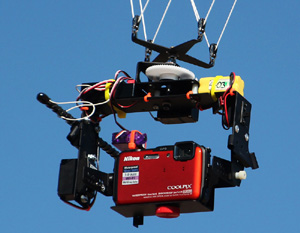
| Cameras and Rigs James S. and Susan W. Aber |
| Introduction | Canon Elph |
| Canon Rebel | Canon S70 |
| Tetracam | Nikon Coolpix |
| Sony Alpha | Color-infrared |

| Cameras and Rigs James S. and Susan W. Aber |
| Introduction | Canon Elph |
| Canon Rebel | Canon S70 |
| Tetracam | Nikon Coolpix |
| Sony Alpha | Color-infrared |
We began with film cameras in 1996 and added digital cameras starting in 2001. High-resolution digital cameras now rival or exceed 35-mm film for image quality, and digital technology has many advantages over film techniques for kite aerial photography. Most important is the ability to review pictures immediately in the field in order to confirm successful photography. The ability to edit, display, and print digital images shortcuts photochemical processing, and digital files do not degrade with time, as color film does. Since 2005, we have utilized digital cameras for all of our kite aerial photography. The section on film camera rigs is given for historical purposes.
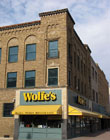
| Most of the cameras described below were purchased from Wolfe's Camera, Topeka, Kansas. Photo at left taken with Canon PowerShot SX10IS, which we used primarily for hand-held ground shots. |
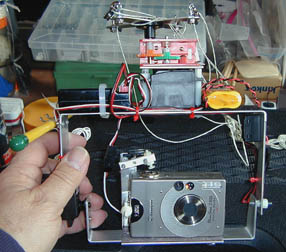
Image courtesy of B. Leffler (2001).
We subsequently acquired the Canon PowerShot S230, which has a 2048x1536 CCD for 3 megapixel resolution, and we modified the radio-controlled rig to fit either version of the camera. Our results with digital KAP are quite satisfactory, and this camera quickly became our first to utilize for routine field work. Image resolution is comparable to 35-mm film for most purposes. The digital pictures are bright with good color balance and require little enhancement for display or printing. The digital capability means that pictures may be reviewed immediately after each flight to determine if the mission was successful. However, both these models suffered from relatively slow shutter speed, which resulted in a high proportion of blurry images.
In 2010, we acquired the Canon EOS Rebel XS 1000D model with a 10.1-megapixel sensor and more advanced functions. It came with a standard 18-55 mm zoom lens with image stabilization, to which we added a 0.7X auxiliary lens. When set to the shortest focal length, this lens combination creates superwide-angle views with focal length equivalent to 12.6 mm (35-mm film equivalent).
We used the S70 camera for many years in the radio-controlled rig. Then in 2015, it transitioned into an autoKAP rig in which it continued to see frequent service. Since 2005, in fact, the S70 was our go-to camera at nearly every site we worked in North America and Europe. We finally retired this veteran camera from active use in 2018.
We acquired a Sony Alpha model 6000 camera in 2017 and also had access to another similar camera that was modified for color-infrared imagery. We constructed two rigs with kits and components from brooxes.com. The first rig is a conventional radio-controlled setup in which an infrared LED triggers the camera shutter. The second rig is for autoKAP, again with an infrared LED to trigger the camera shutter. The color-visible or color-infrared cameras may be used with either rig.
The camera's "auto" function proved impractical for KAP, as the low ISO (100) and slow shutter speed resulted in many blurred images. To correct this problem, we raised the ISO value to 1600, and the images turn out sharp and clear. With a 24-megapixel sensor (6000 x 4000 pixels), the high-resolution images provide great spatial detail. The image format is 3:2 width-to-height ratio, which is the standard for SLR cameras. We normally fit the camera with a 16-mm fixed focal-length lens and UV filter for wide-angle shots.
All text and images © by the authors.Canon EOS Rebel (2004-14)
For digital single-lens reflex (DSLR) cameras, our choice is the Canon EOS Rebel. This series features interchangeable lens, filters, larger image sensors, and various advanced functions. We began in 2004 with the 300D model with 6.3 megapixel resolution. We normally operated the camera with a large zoom lens (10-22 mm) set to the minimum focal length for superwide-angle shots. This camera/lens combination was relatively heavy at 37 oz (~1.05 kg). Once again, Brooks Leffler built a superb camera rig with electronic shutter control. 
Canon EOS Rebel 300D KAP rig
by Brooks Leffler. Photo date 7/04.
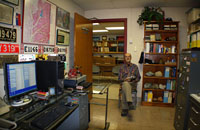
JSA tests the Canon EOS Rebel XS camera rig hanging from the ceiling in his office. The superwide-angle view makes the small room look big. Feb. 2010.
Canon S70 (2005-2018)
One of our favorite digital cameras was the Canon PowerShot S70. This is a compact model with a 7-megapixel sensor array. It has an excellent glass-molded aspherical zoom lens with true wide-angle view (28-100 mm film equivalent). Like the DSLR (above), it has a fast-shutter mode which results in sharp, clear images even with substantial camera motion.

Canon S70 camera rig in flight. This rig is based on the robust titanium frame built by Brooks Leffler originally for a film camera. We constructed a new aluminium cradle to hold the S70 camera, and we added the gent360 to stop pan creep. Total weight of camera and rig is 28 oz (0.8 kg). Photo date 7/05. Tetracam ADC (2008-2009)
The Tetracam Agricultural Digital Camera (ADC) is designed to photograph green, red, and near-infrared portions of the spectrum, specifically 0.52 to 0.92 µm wavelength, at 2048 by 1536 (3 megapixel) resolution. The camera employes a special lens to transmit near-infrared radiation, and blue light is excluded. The resulting pictures are false-color images: green appears as blue, red is shown as green, and near-infrared is red. ![]() Tetracam ADC.
Tetracam ADC.
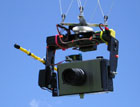
Tetracam ADC camera rig built with some customization from the basic KAP kit by Brooks Leffler. Photo date 6/08. Nikon Coolpix (2014-present)
The Nikon Coolpix model AW 110 was a break with our Canon tradition. It's waterproof, shockproof, and has built-in GPS, world map, compass, and Wi-Fi functions. Camera GPS location and compass look direction are recorded for each picture, which are quite handy for KAP. For this camera, we constructed a radio-controlled rig from the Brooxes Deluxe KAP kit with a few extras—see Brooxes (page down).

Beginning stage of building the Nikon KAP rig. A full sequence of construction stages and tips are presented here for benefit of other KAP enthusiasts. ![]() Building a KAP rig.
Building a KAP rig.
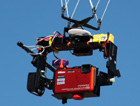
Nikon KAP rig in flight. Because the body is waterproof, a small microservo is used to depress the shutter button.
Sony Alpha 6000 (2017-present)
The Sony Alpha series is an example of mirrorless interchangeable-lens cameras (MILC). These cameras have all the advantages of DSLR cameras, namely interchangeable lenses, use of filters, and large sensor arrays, but without the mirror-and-pentaprism system and optical viewfinder. MILC are, thus, lighter and more compact than equivalent DSLR cameras, which are big advantages for KAP.

Sony color-infrared camera flying in the radio-controlled rig. The photographer on the ground has full control of camera pan, tilt, and shutter. A small infrared LED on the aluminum post (*) triggers the shutter. Total weight of camera, rig, and batteries is ~0.85 kg (~1.9 lb). Thanks to Japanese colleague T. Nagasako for field assistance testing this rig in 2017.
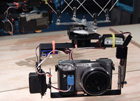
Sony color-visible camera in the autoKAP rig at the workbench. A small electronic device (^) controls automatic pan, tilt, and shutter, and the shutter is triggered by an infrared LED (>), both from J. Gentiles (http://www.gentles.info/). Note the absence of a radio receiver and antenna. Mirror provides back view. ![]() Color-infrared KAP.
Color-infrared KAP.![]()
![]() Return to KAP equipment or KapHome.
Return to KAP equipment or KapHome.
Last update January 2019.